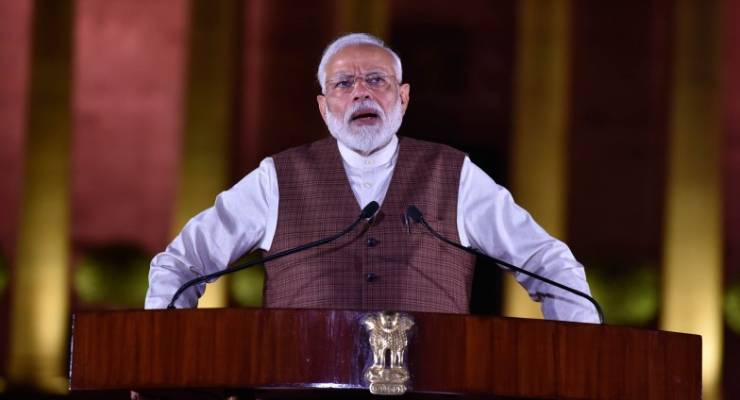
First Wuhan, then Bergamo, followed by New York and London. Now India’s financial hub of Mumbai has become the latest metropolitan epicentre of the COVID-19 pandemic.
Mumbai has become the poster child of the virus’ toll in India, though many other parts of the country are now feeling its weight. Indian infections have passed 325,000, and in the past week cases have spiked in the capital Delhi. Between them the two cities are home to nearly 40 million people.
Infection rates are either as bad or worse as they are in neighbouring countries Pakistan, Bangladesh and Nepal. Together the four nations are home to over 1.7 billion people. No one knows — or will likely ever know — the true toll, with deaths under-reported in the region by as much as 30%.
With India’s healthcare threadbare to non-existent in large swathes of the impoverished countryside, the spear of COVID-19 is rapidly reaching crisis proportions.
The virus’ progress from China, through Europe and south-east Asia, has been non-linear and somewhat puzzling. Much remains unknown about the pathogen and why some communities and groups appear to be more vulnerable to infection.
The dense, often unsanitary urban metropolises of Asia are too often deprived of running water, and in some areas social distancing is close to impossible.
Iran, on the edge of Asia proper, was an early, major casualty. In the original top bracket with Italy and China, Iran is China’s closest ally in the Middle East and as such it easily outstrips all its neighbours for the heavy presence of Chinese business people and tourists. COVID-19 hit before the government could institute a lockdown. Iran is now in the midst of a major second wave.
After Iran, Asia was holding its collective breathe for the seemingly inevitable outbreak, though the impact was initially small in some places and remains so — at least according to official data.
Elsewhere, it behaved unpredictably: Indonesia and the Philippines are the two leading countries for infections and deaths in south-fast Asia while densely populated Vietnam has so far escaped all but scot-free. It should be noted, however, that there there is a huge gulf in COVID-19 testing in south-east Asia compared to the West, Iran, and much of the rest of Asia.
The timing of the Indian pandemic is doubly bad for Australia, coming just as our government, business and media seemed to wake up to what has been increasingly obvious to casual observers: that Australia is dangerously reliant on China for export dollars and low-priced manufacturing.
A recent virtual summit between Scott Morrison and Indian PM Narendra Modi was designed to talk up the opportunity of India, though it’s worth noting that cynics have long used the line that the Indian economy is a promising target for Australia.
As the pair admitted, business is still struggling to make the sorts of inroads that a recent government report thinks are possible. And that was before COVID-19 killed those unrealistic targets stone dead.
Australia appears to have beaten the odds and all but solved its own COVID-19 problem, at least for now. But when major trading partners like India are in crisis, Australia is dead centre for the knock-on effect.
India still ranks number five in Australia’s trading list, but that relationship hinges heavily on fossil fuels and bulk agriculture exports, as well as cheap manufacturing. Both resources and farm goods only have middling demand elasticity — sales slump as economies go south.
India is also racing up the tourist charts in Australia, doubling numbers to 337,000 visitors in the past three years. It’s a trajectory that would have taken it to number two within a decade, or even to one if the Chinese government can gain traction with its anti-Australia narrative.
Meanwhile, Indian tertiary students — who are the number two cohort after China — have surged in recent years.
Even the luckiest, best-managed countries will not be able to dodge a rolling recession that, like the pandemic, is only just beginning. For Asia’s hundreds of millions of poor that is a generational, human tragedy — for Australia, it makes our markets smaller and our security more problematic.
What is happening in India has horror-story potential as train carriages are converted to carry hospital beds. It’s critical for Australia’s immediate future, no matter how quickly we can all get back in the pub.








“After Iran, Asia was holding its collective breathe for the seemingly inevitable outbreak”
Oh dear, somebody told you it’s spelled ‘I can’t breathe’ and you went and did that.
Can we stop blaming a very minor virus for the chaos, the chaos is political only, there is no medical reason for it. It managed to reach .1% of this population of the world in 6 months and the majority are recovering without ever being actually sick.
Why have all media and commentators lost the ability to realise that this is not a big deal and never was.
There’s an Australian manufacturer of cricket bats who has been waiting decades for access to the Indian market, but apparently there are still some forms he hasn’t filled in yet…
Given that my comment on this writer’s last piece on India was obliterated by the Censor, I have little hope of this one surviving.
It is nothing more than regurgitation of an already outdated script from the Assembled Stenographers of the Hegemon.
Has this site no shame whatsoever?